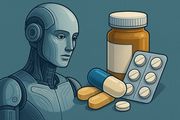What is the relationship between artificial intelligence and the development of pharmaceuticals? One of the most accurate answers lies in the story of a company based in Hong Kong that has begun human trials on a drug completely discovered, designed, and developed using artificial intelligence. This marks a historic shift in the pharmaceutical world, opening up new perspectives on how we approach drug discovery and testing.
Main advantages of AI in drug discovery
- First and foremost, the time required to identify new compounds has been drastically reduced.
- Shorter timelines also lead to significantly lower research and development costs.
In traditional drug development, the discovery phase can take years and involves massive investment. AI changes that by accelerating calculations, simulations, and predictions on how molecules behave inside the body. This acceleration allows for a more dynamic response to emerging health threats and rare diseases.
Applications in the pharmaceutical field
The use of AI in pharmaceuticals includes several cutting-edge applications:
- Discovery of entirely new chemical compounds.
- Re-engineering of existing drugs to improve their efficacy or reduce side effects.
Artificial intelligence can process vast quantities of <a href="https://en.wikipedia.org/wiki/Biomedical_data" target="_blank" rel="nofollow noopener">biomedical data</a> and recognize molecular structures that might be invisible to human researchers. This makes the drug design process more precise, reducing trial-and-error approaches that typically lengthen research cycles.
The case of the Hong Kong company
This particular company launched the first human trial for a drug named “Ins18_055.” It is the world’s first pharmaceutical compound developed entirely with AI support, from initial design to preclinical evaluation. The first patient to receive the drug was a Chinese individual diagnosed with idiopathic pulmonary fibrosis (IPF), a severe and often fatal lung disease that currently lacks fully effective treatments.
About idiopathic pulmonary fibrosis
IPF progressively impairs lung function, reducing the patient’s ability to breathe. If untreated, it can lead to death within two to five years. Currently, only two drugs are used to manage IPF:
- Pirfenidone
- Nintenadib
These treatments provide some relief and slow disease progression, but they cannot halt the underlying condition or reverse existing lung damage. The quality of life often continues to deteriorate, and side effects of current medications can further complicate treatment adherence.
Adverse effects of current medications
- Diarrhea
- Nausea
- Loss of appetite
- Weight loss
Such side effects reduce the patient’s quality of life and may result in discontinuation of treatment. For this reason, new therapeutic solutions are urgently needed.
Clinical testing phases of the new drug
The AI-generated drug underwent multiple phases of testing. Phase 1 primarily evaluates two aspects:
- Safety level
- Human tolerance
This stage involves healthy volunteers and determines how the human body reacts to the drug’s active ingredients. If results are positive, the trial proceeds to Phase 2. This is a critical milestone, as it shifts the testing from laboratory theory to clinical application.
Identifying side effects
One of the goals of the early phases is to assess side effects based on dosage. Volunteers are divided into groups and given different amounts of the drug to monitor adverse reactions. These insights guide future dosage adjustments and long-term safety protocols. Researchers also take into account individual variability and how certain populations may react differently.
Phase 2 and toxicity assessment
Once toxicity is found to be within acceptable limits, Phase 2 begins. It involves a group of patients who actually suffer from IPF. This phase verifies therapeutic efficacy in real-world conditions, providing evidence on both symptom management and disease impact.
Should this phase prove successful, the drug will progress to larger-scale Phase 3 trials, involving hundreds of patients and broader monitoring of clinical effectiveness and safety. These final stages are essential for gathering data to present to regulatory bodies for approval.
How generative AI accelerates the process
Generative artificial intelligence plays a central role in identifying pharmaceutical targets with unprecedented speed. It rapidly scans huge databases and simulations to pinpoint viable options for drug development. This not only reduces time, but increases accuracy and relevance of molecular design. AI can generate thousands of potential compound structures in hours, whereas traditional teams would take weeks or months.
Key benefits
- Time savings estimated between two and four years compared to traditional methods.
- Greater chance of success due to improved chemical structures and optimized target selection.
- Reduced early-stage failure rates through more informed predictions.
Patient profiling: AI was also used to select patients most likely to respond positively to the therapy, based on their clinical and genetic profiles. This contributes to more personalized and effective treatment strategies. In the future, this approach could pave the way for AI-led precision medicine across multiple diseases.
Final considerations
AI has shown enormous potential in revolutionizing pharmaceuticals. However, regulatory bodies like the FDA (U.S.) and AIFA (Italy) have yet to approve any drug entirely developed by AI. At present, such drugs remain in clinical testing stages and are monitored under strict scientific supervision. AI’s role continues to expand, but human oversight remains irreplaceable.
While the future is promising, challenges remain. Ongoing research and new trials are necessary to confirm long-term safety and real-world applicability. Human involvement ensures ethical compliance, accuracy, and above all, patient safety. Collaboration between scientists, engineers, and regulatory institutions will define the true potential of this technological leap.

